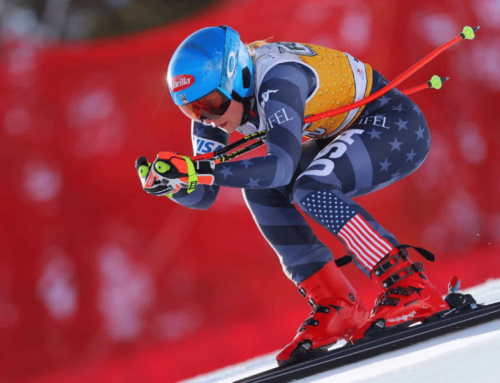Nicole Schmidhofer Reflects on Career Best Season
Nicole Schmidhofer is a prime example of the belief that persistence pays off. The 30-year-old made her World Cup debut at the age of 18 when she took 14th in the super-G in Lenzerheide, Switzerland back in 2007. But it wasn’t until 2013 that the Austrian was able to break onto the podium in super-G. While she has always been a contender for a spot in the top 15 and has won a super-G gold at World Championships in 2017, 2018/19 saw Schmidhofer’s most consistent performance.
She kicked off the season with two downhill wins in Lake Louise, the first of her career. She then earned second-place podiums in the Val Gardena super-G, Cortina downhill, and Crans-Montana downhill, then won again in Garmisch. Not once did she finish outside of the top 15, which led to a moment she had been striving for her entire career – raising the downhill crystal globe over her head at World Finals.
“Wearing the red jersey for the first time was something very special and gave me extra motivation at every race,” she said. “I’ve been in the World Cup for a long time and my big goal for this season was to be constantly in the top 5 and in the top 3 of a discipline ranking at the end. The downhill crystal globe is the reward for long, hard work with many sacrifices and great teamwork. But It was only possible with the perfect combination of support from family, coaches, service technician, teammates, physios and friends.”
Schmidhofer was joined by her teammates, Stephanie Venier and Ramona Siebenhofer on the downhill final ranking podium at World Finals, an Austrian sweep that reflected the overall domination of the women’s speed team last season. Rarely did the women’s speed circuit see a race where an Austrian woman was not on the podium. By the end of the season, the Austrian women’s team had a total of 86 top-ten finishes collectively, large in part due to the consistency of the women’s speed team.

Stephanie Venier, Nicole Schmidhofer and Ramona Siebenhofer (AUT) celebrate on the final downhill podium at World Finals in Soldeu, Andorra. Photo: GEPA pictures/ Andreas Pranter
“Our team spirit made this result possible. We are not only teammates but also friends who go out for a coffee together or sit at the bar in the evening,” explains Schmidhofer. “We are having fun together, which I think is important, and we push and help each other. We often inspect the course together and pass on radio messages to the start to get the best results possible. When someone is on the podium, everyone from the team is always there in support and this sense of community makes us strong!”
A few big coaching changes had been made prior to the 2018/19 season, which Schmidhofer says played a huge role, not only in the overall success of her team but in her personal success as well. Coming into Lake Louise she felt stronger than she ever had before, and was able to collaborate with her Fischer technician to make some important equipment changes that helped her skiing dramatically. Everything finally came together for her to win her first crystal globe, and while the moment was magical, her 2017 World Champion gold medal still holds a special place in her heart.
“For me, the victories are very difficult to compare! Emotionally nothing beats the gold medal. It was very unexpected after my knee injury in the preseason. Also, the fact that my parents came to watch me racing in St. Moritz, which is rather rare, was insane. I will never forget these emotions that were created during the race. Also, the amazing welcome celebration in my home Lachtal was unbelievable,” she says. “From a sporting perspective, the crystal globe means more. It’s the result of a whole seasons performance. It’s not the daily condition or one good run that counts. A lot of races have to run well and you have to give your full commitment for four months. I am super proud of both and don’t want to rank anything above the other.”
If her overall downhill victory was not enough, Schmidhofer then went on to set an Austrian record at Speed Skiing World Championships. Even as a newcomer, she was able to post a top speed of 217.590 kilometers per hour (about 135 miles per hour) and finish fourth overall.
“I wanted to participate already in a speed event a year earlier, but it didn’t fit into the program. When I had the opportunity this year to race on a track where I can ski over 200 km/h, I didn’t hesitate,” says Schmidhofer. “My goal was to go over 200 km/h, and when I qualified for the best 5 for the finals, I naturally wanted to compete for the medal. The 4th place was a matter of bad luck, but for having made only a minimal effort it is very considerable, and the 217,59 km/h is more than I had hoped for.”





















